Error
Malawi new 20-kwacha note error reported
29 05, 2012 11:17 Category: Africa
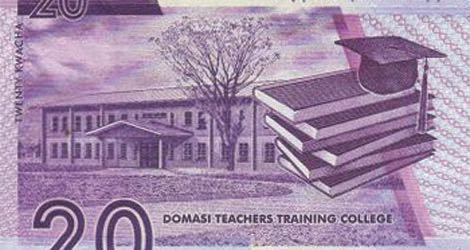
According to an article on Malawi Today dated 27 May 2012, the new 20-kwacha (US$0.08) note issued on 23 May contains an error. On the back of the note is a building identified as the Domasi Teachers Training College (now known as the Domasi College of Education). However it's reported that the building is in fact the Machinga Teachers Training College. Reserve Bank of Malawi spokesperson Ralph Tseka played down the issue, saying the error would not affect the legal tender as the rest of the security features are intact. "We are going to verify and if we find the error we will make a correction in the next issue," said Tseka.
I have been unable to find any images of either college online to confirm that this is in fact an error. Any assistance in this regard would be greatly appreciated.
Courtesy of Richard Miranda.
Bangladesh new 50-taka note withdrawn due to error
13 03, 2012 09:03 Category: South Asia
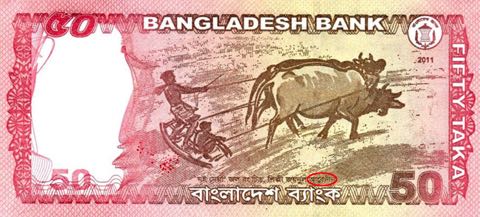
According to an article in Banglanews24 dated 7 March 2012, Bangladesh Bank has withdrawn the new 50-taka (US$0.60) note after a spelling mistake of Shilpacharya Zainul Abedin was identified on the back of the note. The note had just been introduced earlier in the day on 7 March, so it's likely that very few made it into circulation, even though 2.25 crore pieces were printed. Confirming the matter, Director-General of BB Governor Secretariat AFM Asaduzzaman said, “These notes will not be circulated in the market before rectifying," giving the impression that the bank may overprint the error notes with corrected text rather than destroy them.
Courtesy of Frank van Tiel.
Belarus 50,000-ruble note contains error in microprinting
23 02, 2012 12:16 Category: Europe

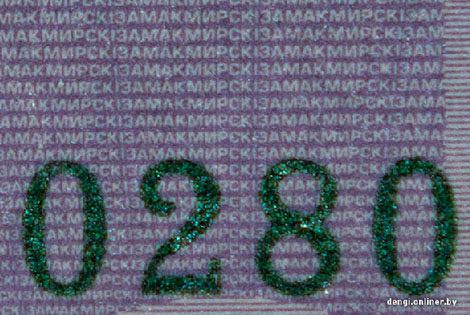
According to a Belarus Partisan article dated 23 February 2012, the 50,000-ruble (US$6.10) note which depicts Mir Castle has an error in the microprinting above the serial number at upper right on the back. If written properly in Belarusian, the name of Mir Castle should read МІРСКІ ЗАМАК (as it is written in large type in the caption on the front, as well as in the mircorprinted rectangle below the denomination at upper left on the front), but instead the text is written МИРСКІ ЗАМАК. Officials at the KGB and the National Bank of the Republic of Belarus claim that this is an intentional error intended to trip up counterfeiters, which may be true. Then again, it’s possible that the Russian engravers at Goznak simply made a mistake that has gone undetected for a decade.
This “error” appears on both the original 50,000-ruble note (NBRB B32 / P32) issued in 2002 with solid security thread, as well as on the modified note (NBRB B35 / PNL) issued in 2010 with windowed security thread.
Use Google Translate if you can’t read the article in its native language.
Courtesy of Vitali Khaletski.
Brunei's new notes contain Braille blunder
19 08, 2011 16:33 Category: East and Southeast Asia

According to an article in the Brunei Times dated 9 August 2011, the dots in the upper left front corner of new polymer banknotes issed 18 July 2011 are intended to assist the sight-impaired, but they are not raised, so they can’t be felt tactilely, and they are not accurately rendered as Braille numbers corresponding to the denominations. Specifically, the spacing of the dots is wrong, and the lack the lead-in character that indicates that numbers follow.
Congo Democratic Republic new 500-franc variety/error confirmed
10 04, 2011 08:10 Category: Africa


500 francs (US$1.10), 04.01.2002. Like P96, but lacking the three diamonds to the left of the watermark area on the front (top image). Both notes bear the imprint of GIESECKE & DEVRIENT MUNICH (the imprint is very faint, printed at lower right on back).
I’m not sure if this is an error note or an intentional new variety. On the “normal” note (bottom image), the diamonds appear to be printed as part of the rest of the design, so it’s not as if the underprinting or an overprinting was omitted by mistake. It may be that the diamonds were removed to make the design of the note conform to the other denominations in this family, none of which have any similar elements in the same location. Does anyone else have examples of this note to report?
Courtesy of Andrew Roberts.
Belarus language changes create errors on old notes
05 11, 2010 14:32 Category: Europe
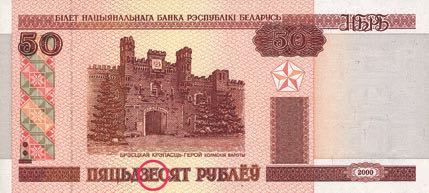
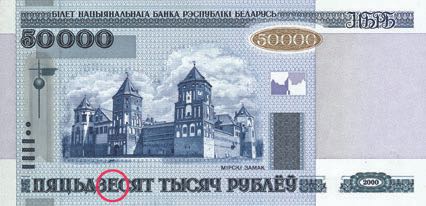
According to an article on the Belarus Partisan dated 05.11.2010, on 1 September 2010, new rules of Belarusian orthography came into force. According to the old rules, the correct spelling of the word “fifty” in Belarusian was “пяцьдзЕсят,” but under the new rules, it should be spelled “пяцьдзЯсят,” the difference being that the seventh character was the Cyrillic letter IE but is now the Cyrillic letter YA. As a result of these new rules, the existing 50- and 50,000-ruble notes (Pick 25 and Pick 32, respectively) dated 2000 now technically contain errors where the denominations are spelled out on the backs of the notes. Belarus National Bank intends to correct these spelling errors when it issues new versions of these denominations, but there is no word yet on when that may be.
Courtesy of Vitali Khaletski.
Bangladesh 20-taka error confirmed
05 09, 2009 10:08 Category: South Asia
While editing the Bangladesh chapter of my new catalog of world notes, Bill Stubkjaer and I confirmed that his example of the Bangladesh 20-taka note of 1979 (Pick 22) has an error in the printed solid security thread. Specifically, the words BANGLADESH BANK are repeated on the thread, but the Bs are backwords and BANK is spelled with an X, not a K:
I'd appreciate it if collectors would examine their own examples of this note and report if varieties exist with the correct spelling. Please post comments with your findings either way.
Canada 10-dollar error notes reported
26 07, 2009 09:50 Category: North America
Some Canadian 10-dollar notes printed in 2007 with the Jenkins-Dodge signature combination were printed on paper intended for 20-dollar notes. They therefore have Queen Elizabeth's portrait and the number 20 as the watermark, a security thread with demetalized "Canada 20", and the holographic stripe with the number 20. There are at least three ranges of the error notes with prefixes BTT and BTU. Six notes have been confirmed so far, though there could be many more notes in circulation.
For more information, please visit Canadian Paper Money.
For more information, please visit Canadian Paper Money.
Canadian Journey 20-dollar error note surfaces
20 07, 2007 15:29 Category: North America
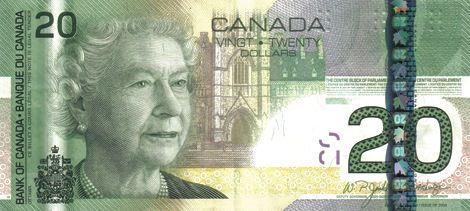

Winston Brown of Toronto, Ontario, has recently gone public with a dramatic example of a modern error. The $20 from 2004’s Canadian Journey series has the holographic stripe on the front right, the windowed security thread on the back right, and the watermark is upside down (compare top pair of images with normal note below).
The Bank of Canada has confirmed that the note is genuine and postulates that the error is a result of an uncut sheet of banknote paper being being rotated 180 degrees before being fed into its presses in Ottawa. Since each sheet contains 45 notes, there must have been 44 other examples of this error with serial numbers similar to that found on Brown’s note: EZM7459230. However, his note was found in circulation in 2006 (though a 2004 issue, the note is dated 2006 on the back), and Brown isn’t aware of any other similar notes that have surfaced to date. It’s possible they escaped notice and may be lost, destroyed, collected, or waiting to be discovered.
Brown intends to sell his error note via auction at some point in the future. Interested parties may contact him via email: w_brown_2007@hotmail.com.
Courtesy of Winston Brown.

